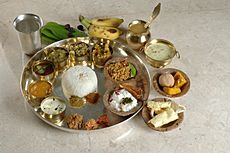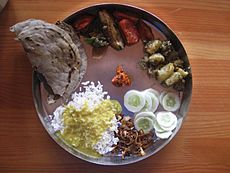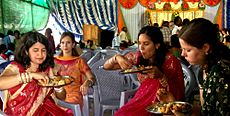Customs and etiquette in Indian dining facts for kids
The etiquette of Indian dining and socializing can be different depending on the region in India. It's a fascinating part of Indian culture!
Before eating, people in India always wash their hands very well. Many traditionally eat with their fingers, using very few forks or spoons. This custom is very old. It's believed that eating is a sensory experience. Touching your food adds to the taste and smell. You can also feel the food's temperature and mix flavors with your fingers.
When eating rice, people often mix it with curry. They pick up small amounts with their fingers and push it into their mouth with their thumb. For breads like roti or naan, small pieces are folded. These are used like a scoop to pick up curry. Most Indian food is already bite-sized. But if there's a larger piece, like a chicken leg, it's fine to eat it with your hands.
Traditionally, people often sit on floor mats in comfortable clothes to eat. Today, in restaurants and many modern homes, tables and chairs are common.
Contents
Using Your Hands Wisely
When eating with your fingers, people usually use only one hand, their dominant hand. The other hand stays clean and is used for passing dishes or drinking water.
Sometimes, people who eat meat and those who are strict vegetarians eat together. It's important not to mix cooking or serving tools between these different foods. This respects the spiritual beliefs of vegetarians who practice non-violence towards animals.
Keeping Things Clean
Cleanliness is very important during meals. People do not dip their fingers or cutlery into food if they have already put them in their mouth. This also applies to cooks. A cook will not taste food and then use the same spoon to stir the pot again. Once a utensil is used for tasting, it is set aside to be washed.
Food that has been touched by fingers or cutlery used for eating is called jootha or Uchchhishta. This means it's considered "contaminated." This rule helps prevent the spread of germs and keeps everyone healthy.
What About Spices?
Indian food uses many whole spices like cloves, bay leaves, or cinnamon sticks. These spices add a lot of flavor. However, you are not meant to eat them. Diners usually just move them to the side of their plate.
Sharing Meals and Conversation
Eating is usually a time for family and friends to gather. The person who prepared the meal, often the homemaker, will watch the table. They will offer more food to make sure everyone has enough. However, naan bread is usually not shared among diners.
At bigger gatherings or celebrations, someone might volunteer to serve. This person might not eat with the group. Instead, they focus on bringing food courses and serving everyone. It's perfectly fine to ask for more food or to help yourself to dishes. Special requests, like wanting less spice or more yogurt, are usually welcomed.
Sometimes, people might eat quietly. But it's also common and encouraged to chat. People often catch up on their day or discuss different topics about life and society.
Food Waste and Offerings
In some regions, it's a tradition not to waste any food on your plate. In other places, people might only eat what they feel like and leave the rest. There are also some regions where leaving food as an offering is common. Some believe this helps them only take in the "pure spirits" of the food. The discarded food then represents "evil spirits" from the past.
After the meal, it's normal to wash your hands. A towel is usually provided for drying them.
Meal Structure and Ayurveda
For many communities in India, ancient Ayurveda beliefs have shaped how and when they eat. A common saying is: "Breakfast moderately, lunch well and eat dinner very sparingly."
Ayurveda teaches that each day has different periods. These periods are linked to different energies in our body called doshas. One of these is Pitta dosha. It helps with digestion, like making you hungry, producing saliva, and breaking down food. Pitta dosha is strongest around noon because it's influenced by the sun.
Because of this, lunch has traditionally been the main meal of the day for many communities. Dinner is usually light. It often has less starchy foods or dairy. This is because foods high in sugar can cause an imbalance in another dosha called Kapha dosha, according to Ayurveda.
See also
 In Spanish: Etiqueta sobre la mesa en la India para niños
In Spanish: Etiqueta sobre la mesa en la India para niños




